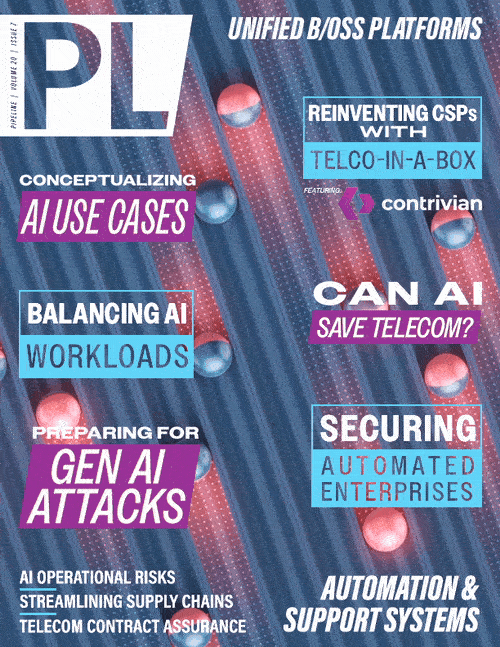Can Generative AI Become the Saviour
of the Telecoms Industry?
IBM: Using AI to Streamline Customer Experience and Workflows
IBM, according to Rich Sarcomo, Partner in IBM Consulting, isn’t a new entrant to the use of AI in communications. In fact, the Watsonx platform launched in 2016 has been driving change and innovation within the industry for the last seven years.
However, the introduction of GenAI has further accelerated adoption within the industry, driving new use cases particularly in call centres, customer care, and field service areas which are typically manpower intensive operations. Much of the productivity improvements IBM has seen have been based on the concept of “intent,” understanding what the customer wants. At the front-end, well-trained chatbots can complete 70-80 percent of tasks with AI’s either completing tasks entirely or understanding when to deflect them to human advisors. The deflection to human agents is accompanied by the full context of engagements so that service agents have the knowledge required to complete the task without re-asking for information. In addition, the asynchronous nature of such engagements particularly suits the younger “millennial” customers.
To understand why GenAI is so effective in managing customer engagement you need to understand that legacy automated workflows required a “hard-coding” of the process, which made changes to policy and processes slow to implement. With GenAI you can effectively say, “Read the manual,” and direct the AI to utilize the current policy for billing upgrades or change of address or any other of the numerous tasks a customer may want them to perform. A change of the published policy effectively then changes the workflow without any additional coding changes required. While it sounds simple, its impact on CSP business is huge. The use of AI agents and the use of AI-assisted human agents impacts the business by:
- Reducing handling time.
- Improving first call resolution.
- Improving overall CX/NPS.
- Avoiding swivel-chair operations.
Today, IBM sees AI being added to current processes and workflows. In the future, however, these processes and workflows will be built around AI. AI is such a powerful tool it shouldn’t be constrained by the limits of existing processes. With AI you have to re-imagine the process.
IBM is already seeing AI use cases improving net promoter score (NPS) by 15-20 percent, but one of the major concerns is that of governance and data privacy. A service provider’s private data shouldn’t be used to train public models, and within the telco domain AI needs certain “guardrails” and responses.
One of the problems that AI is already helping with is an ubiquitous challenge for service providers, which is: “If I have an outage, and the customer hasn’t yet noticed, do I tell them?” IBM has developed an AI solution that identifies which customers are most likely to call and targets them with proactive communication, whereas customers unlikely to call are not.
Netcracker: Learn to Walk Before you Run, but Don't Wait to Take the First Steps
Sue White, Head of Strategy & Portfolio Marketing at Netcracker, pointed out that “GenAI has taken all industries but in telecoms the challenge is how to add meaningful telco data.” This is the challenge that Netcracker has addressed with their GenAI Telco Platform launched in 2023.
To effectively use AI in the telco domain you must be able to support multiple models, manage proprietary telco data, and utilize secure user data. Service providers need to have a flexible AI model strategy that allows them to use multiple models, including common public models, and potentially some of the emerging telco specific LLMs being developed. Whatever service providers do they must have flexibility over model choice and the ability to add new models as they become available. Service Providers will strongly resist any attempts at “vendor lock-in” in AI. Another important factor for service providers is data quality. Telecom networks are complex and dynamic, and using AI in the telecom domain needs access to high quality, accurate, real-time data from the BSS, OSS and Network. This data together with instructions augments AI model training to give higher quality responses. The challenge is that for many service providers the real-time data issue has still not been fully resolved. Finally, service providers have to be able to manage data security. Individual customer data can’t be accessible in public AI models. Data has to be anonymous and obfuscated in all directions to avoid damaging data breaches.
Netcracker sees an almost ubiquitous deployment of GenAI in the BSS layer today to assist with customer service, resolve queries, and automate catalog configurations, but they also expect GenAI to generate significant use in the OSS and Network layers to address issues such as configuration management, network assurance, fault resolution, and data cleansing. In fact, their expectation is that GenAI driven operational applications will be a major growth area. The early use cases will be relatively simple, but as the technology progresses AND service providers complete their digital transformation of the BSS/OSS to provide real-time capabilities, we will see more and more complex and powerful use cases being deployed.



















